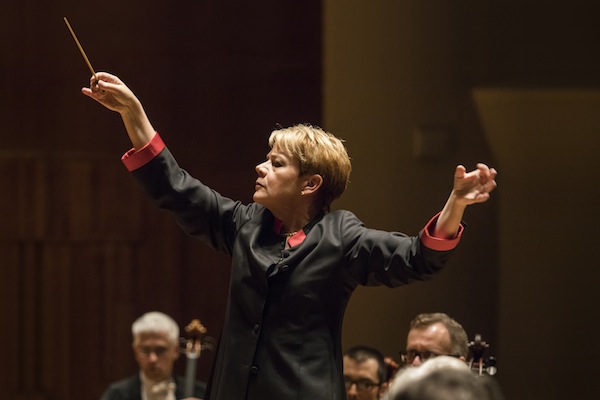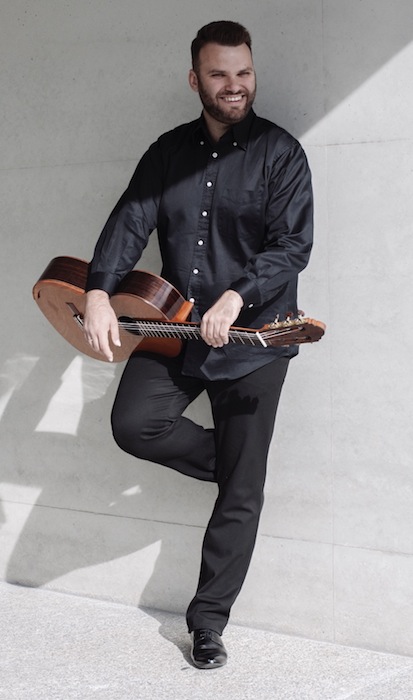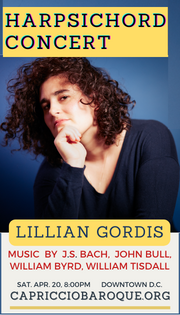Dynamic Adams and Tchaikovsky open Alsop’s tenth season with Baltimore Symphony

Marin Alsop conducted the Baltimore Symphony Orchestra’s season-opening concert Thursday night at Strathmore. File photo: Jason Dixson
Audiences may be getting tired of orchestras playing the same pieces over and over as much as critics do. That could explain the bald patches in the crowd gathered in the Music Center at Strathmore Thursday night for the season opener of the Baltimore Symphony Orchestra. The program, packed with putative audience pleasers like Joaquín Rodrigo’s Concierto de Aranjuez and Tchaikovsky’s Fifth Symphony, should have attracted more ears than it did.
Music director Marin Alsop, at the start of her tenth season with the BSO, opened this concert with two feisty miniatures by John Adams. The older piece, Short Ride in a Fast Machine, is a rollicking fanfare from 1986, making a bracing antidote to the lugubrious rendition of The Star-Spangled Banner that preceded it.
Alsop hit just the right tempo to bring out Adams’ ebullient rhythms, crossing a pulsating beat in the woodblock and other percussion instruments. Her confidence navigating the metric shifts in the work transferred to the musicians. They responded as one with crescendo swells and other signs to mark the “gate” moments in the piece, where the rhythmic patterns shift.
That proved much stronger than the second Adams piece, Lola Montez Does the Spider Dance. Composed last year in honor of Alsop’s 25th and final season leading the Cabrillo Festival of Contemporary Music in California, the work is more refined in orchestration but less flashy in its gestures. Lola Montez traverses the orchestra skillfully, drawing out vaporous high notes from the woodwinds and booming low notes from the brass. It is a more narrative work, too, related to the composer’s new opera, Girls of the Golden West, which premieres November 21 at San Francisco Opera.

Lukasz Kuropaczewski. Photo: Kamil Strudzinski
Łukasz Kuropaczewski, who did his graduate studies at Peabody Conservatory in Baltimore, returned to play the Concierto de Aranjuez. The orchestration of the piece is delicate enough to balance with an unamplified guitar, but perhaps not in a room as large as this. It is unfortunate, because the amplification added a tinny sonic overlay to what was generally a fine rendition; it also emphasized some intonation issues towards the end of the central movement.
Kuropaczewski had the technical fortitude to make the shorter first and third movements sparkle like folk music-inspired dances, and he drew out the famous second movement with concentrated intensity from each phrase.
Alsop and the BSO matched him in evoking what the composer identified as “the fragrance of magnolias, the singing of birds, and the gushing of fountains” in the gardens of the Palacio Real de Aranjuez, with particularly languorous English horn solos in the slow movement by Jane Marvine. Kuropaczewski also played a long encore, “Leyenda” from Chants d’Espagne by Isaac Albéniz.
Alsop’s interpretation of the symphonies of Tchaikovsky has deepened over the years. More than just focusing on the blaring, forceful moments, she elicited other qualities from the orchestra, which dug into this familiar music with admirable vigor. The opening of the first movement, steeped in gloom, had plenty of rubato to allow the clarinets, set in their deep chalumeau register, to muse over the low strings. The orchestra gave each thematic section a vibrant character, without always joining them into a larger arc, concluding the movement in an eerie cloud, that soft minor third set deep in the bass instruments.
The second movement proved the highlight, in spite of some surprising flubs from the excellent principal horn Philip Munds in his initial solo. Here Alsop’s pushing at the edges of the tempo gave the piece a restless quality, and throughout the symphony the brass incised the recurring theme with biting clarity. The “Valse” felt genial in its opening section, but the tempo proved too fast for the later variations.
Tchaikovsky himself expressed fears that he had missed the mark with the end of his symphony, and the honest listener of this performance, as of most others, may agree with him. It is easy enough to make the bombastic finale succeed, but Alsop front-loaded the movement with a frenetic pacing that made it harder to ratchet up the rhetoric later. The BSO gave the finale enough force and excitement to lift the audience to its feet, marking an auspicious start to this landmark season for Marin Alsop.
The program will be repeated 8 p.m. Friday and Saturday at Meyerhoff Symphony Hall. bsomusic.org; 410-783-8000.







